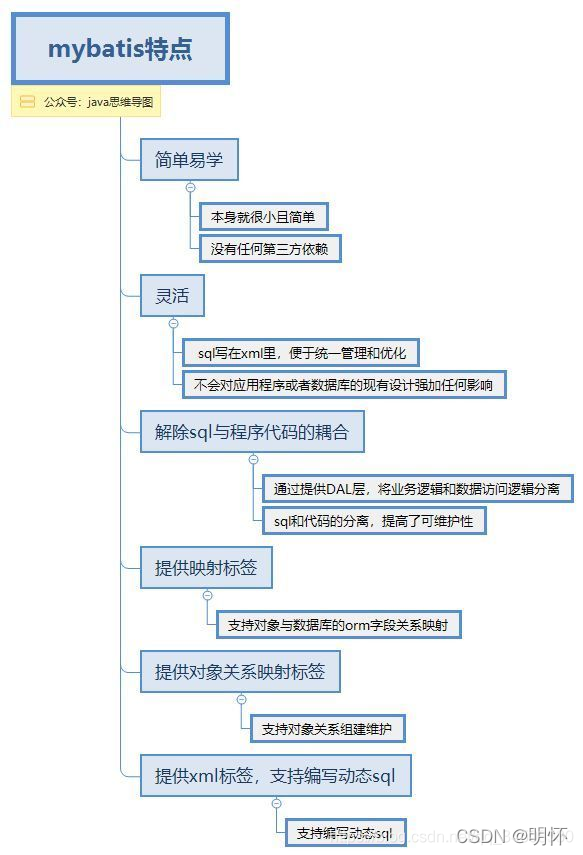
Mybatis-plus和Mybatis的区别和详情讲解(附代码详解)
文章目录1.简介2.Mybatis2.1Mapper层2.2Service层2.3Controller层3.Mybatis-plus3.1为什么使用mybatis-plus?3.2如何使用它Mybatis-plus?3.3如何实现一些特殊的sql语句呢?4.总结1.简介首先,在介绍Mybatis-plus之前呢,明怀我想给大家介绍一下Mybatis,其实mp(mybatis-plus)是对myba
文章目录
1.简介
首先,在介绍Mybatis-plus之前呢,明怀我想给大家介绍一下Mybatis,其实mp(mybatis-plus)是对mybatis的一个增强,我更推荐大家在使用的时候可以结合着Mybatis和mp一起使用
2.Mybatis

2.1Mapper层
mybatis在使用的过程当中,这里我再简要地来做一下讲解吧,首先也是建立相应的数据库表,然后再通过建立对应的实体类,着我想没必要再写上了吧,然后,需要做的就是书写对应的接口:
package com.example.qhb.model.mapper;
import com.example.qhb.model.entity.RedDetail;
import org.springframework.stereotype.Repository;
import org.springframework.stereotype.Service;
/*
2022.1.18
*/
@Service
public interface RedDetailMapper {
int deleteByPrimaryKey(Integer id);//根据主键id删除
int insert(RedDetail record);//插入数据记录
int insertSelective(RedDetail record);//插入数据记录
RedDetail selectByPrimaryKey(Integer id);//根据主键id查询记录
int updateByPrimaryKeySelective(RedDetail record);//更新数据记录
int updateByPrimaryKey(RedDetail record);//更新数据记录
}
然后,我们又该怎么做呢,那就是针对这个接口设置相应的相应的xml文件,在这里面就是设置的是:
1.建立结果集映射,也就是代码中的resultMap。
2.根据具体的sql语句,书写出来对应的sql
<?xml version="1.0" encoding="UTF-8" ?>
<!DOCTYPE mapper PUBLIC "-//mybatis.org//DTD Mapper 3.0//EN"
"http://mybatis.org/dtd/mybatis-3-mapper.dtd">
<mapper namespace="com.example.qhb.model.mapper.RedDetailMapper">
<!--定义查询结果集映射-->
<resultMap id="BaseResultMap" type="com.example.qhb.model.entity.RedDetail">
<result column="id" property="id" jdbcType="INTEGER"/>
<result column="record_id" property="recordId" jdbcType="INTEGER"/>
<result column="amount" property="amount" jdbcType="DECIMAL"/>
<result column="is_active" property="isActive" jdbcType="TINYINT"/>
<result column="create_time" property="createTime" jdbcType="TIMESTAMP"/>
</resultMap>
<sql id="Base_Column_List">
id,record_id,amount,is_active,create_time
</sql>
<!--根据主键查询数据库-->
<select id="selectByPrimaryKey" resultMap="BaseResultMap" parameterType="java.lang.Integer">
select
<include refid="Base_Column_List"/>
from red_detail
where id=#{id,jdbcType=INTEGER}
</select>
<!--根据主键删除数据记录-->
<delete id="deleteByPrimaryKey" parameterType="java.lang.Integer" >
delete from red_detail
where id = #{id, jdbcType=INTEGER}
</delete>
<!--新增数据记录(不带判断条件)-->
<insert id="insert" parameterType="com.example.qhb.model.entity.RedDetail" >
insert into red_detail (id, record_id, amount, is_active, create_time)
values (#{id, jdbcType=INTEGER}, #{recordId, jdbcType=INTEGER},
#{amount,jdbcType=DECIMAL},
#{isActive, jdbcType=TINYINT},
#{createTime, jdbcType=TIMESTAMP})
</insert>
<!--新增数据记录(带判断条件)-->
<insert id="insertSelective" parameterType="com.example.qhb.model.entity.RedDetail" >
insert into red_detail <trim prefix="(" suffix=")" suffixOverrides=",">
<if test="id ! = null" >id ,</if>
<if test="recordId ! = null" >record_id, </if>
<if test="amount ! = null" >amount,</if>
<if test="isActive ! = null" >
is_active,
</if> <if test="createTime ! = null" >
create_time,
</if> </trim>
<trim prefix="values (" suffix=")" suffixOverrides=", " >
<if test="id ! = null" >
#{id, jdbcType=INTEGER},
</if> <if test="recordId ! = null" >
#{recordId, jdbcType=INTEGER},
</if> <if test="amount ! = null" >
#{amount, jdbcType=DECIMAL},
</if> <if test="isActive ! = null" >
#{isActive, jdbcType=TINYINT},
</if> <if test="createTime ! = null" >
#{createTime, jdbcType=TIMESTAMP},
</if>
</trim>
</insert>
<!--更新数据记录-->
<update id="updateByPrimaryKeySelective" parameterType="com.example.qhb.model.entity.RedDetail" >
update red_detail <set >
<if test="recordId ! = null" >
record_id = #{recordId, jdbcType=INTEGER},
</if>
<if test="amount ! = null" >
amount = #{amount, jdbcType=DECIMAL},
</if>
<if test="isActive ! = null" >
is_active = #{isActive, jdbcType=TINYINT},
</if>
<if test="createTime ! = null" >
create_time = #{createTime, jdbcType=TIMESTAMP},
</if> </set> where id = #{id, jdbcType=INTEGER}
</update>
<!--更新数据记录-->
<update id="updateByPrimaryKey" parameterType="com.example.qhb.model.entity.RedDetail">
update red_detail
set record_id=#{recordid,jdbcType=INTEGER},
amount=#{amount,jdbcType=DECIMAL},
is_active=#{isActive,jdbcType=TINYINT},
create_time=#{createTime,jdbcType=TIMESTAMP}
where id=#{id,jdbcType=INTEGER}
</update>
</mapper>
2.2Service层
接下来,对应的就是编写相应的service层,你需要哪些业务的时候,只需要设置相应的接口,然后对这些接口进行实现类的操作,那么下一次就是可以在Controller里面通过指定相应的方法来执行。
首先,这里也是进行相应的接口编写,这个接口里面的名字,就要仔细思考,尽量和实际的业务名称一样才行。
package com.example.qhb.server.service;
import com.example.qhb.server.dto.RedPacketDto;
import java.math.BigDecimal;
import java.util.List;
public interface IRedService {
//记录发红包时红包的全局唯一标识串、随机金额列表和个数等信息入数据库
void recordRedPacket(RedPacketDto dto, String redId, List<Integer> list)
throws Exception;
//记录抢红包时用户抢到的红包金额等信息入数据库
void recordRobRedPacket(Integer userId, String redId, BigDecimal amount) throws Exception;
}
接下来就是针对着这些接口,设置相应的实现类,这里面的实现,首先要注意以下几点:
1.首先是要通过Autowired进行对应Mapper实例的注入
2.在对应的Service方法里面进行mapper的引用即可
2.3Controller层
在这一层当中,我们需要注意的就是设置对应的访问地址信息,然后建立通过Service层的访问即可…
3.Mybatis-plus
3.1为什么使用mybatis-plus?
看了上面的mybatis的一些配置,看了之后,明怀我属实都有点麻木了,怎么只是介绍了一个mapper都要配置那么多的sql语句,一旦落实到大的项目中,那岂不是玩完了吗,于是,我想到了借用mp来进行封装,mp完全脱离了大量的xml文件的配置,内置通用Mapper,通用Service,支持多种主键策略,包括解决主键自增问题,也就是只需要在接口、实体类、实现类中实现固定的继承,就可以完成大量的sql语句封装,这样岂不是更加轻松了吗,好啦,话不多说,我们直接开讲!
3.2如何使用它Mybatis-plus?
首先,我们需要保证自己是使用Spring-boot框架来搭建出的项目,于是这个时候,我们就可以先引入依赖
1.引入依赖
<!-- mybatis mybatis-plus mybatis-spring mvc -->
<dependency>
<groupId>com.baomidou</groupId>
<artifactId>mybatis-plus</artifactId>
<version>${mybatis-plus.version}</version>
</dependency>
接下来就是建立相应的实体类,包括对应表的column
2.建立实体类
package com.atguigu.yygh.model.hosp;
import com.atguigu.yygh.model.base.BaseEntity;
import com.baomidou.mybatisplus.annotation.TableField;
import com.baomidou.mybatisplus.annotation.TableName;
import io.swagger.annotations.ApiModel;
import io.swagger.annotations.ApiModelProperty;
import lombok.Data;
/**
* <p>
* HospitalSet
* </p>
*
* @author qy
*/
@Data
@ApiModel(description = "医院设置")
@TableName("hospital_set")
public class HospitalSet extends BaseEntity {
private static final long serialVersionUID = 1L;
@ApiModelProperty(value = "医院名称")
@TableField("hosname")
private String hosname;
@ApiModelProperty(value = "医院编号")
@TableField("hoscode")
private String hoscode;
@ApiModelProperty(value = "api基础路径")
@TableField("api_url")
private String apiUrl;
@ApiModelProperty(value = "签名秘钥")
@TableField("sign_key")
private String signKey;
@ApiModelProperty(value = "联系人姓名")
@TableField("contacts_name")
private String contactsName;
@ApiModelProperty(value = "联系人手机")
@TableField("contacts_phone")
private String contactsPhone;
@ApiModelProperty(value = "状态")
@TableField("status")
private Integer status;
}
接下来我们需要做的就是书写对应的接口,其实就是很简单的实现了mapper一起的操作
package com.atguigu.yygh.hosp.mapper;
import com.atguigu.yygh.model.hosp.HospitalSet;
import com.baomidou.mybatisplus.core.mapper.BaseMapper;
public interface HospitalSetMapper extends BaseMapper<HospitalSet> {
}
那么我们进入这个BaseMapper<HospitalSet>进去看看到底写了什么
package com.baomidou.mybatisplus.core.mapper;
import com.baomidou.mybatisplus.core.conditions.Wrapper;
import com.baomidou.mybatisplus.core.metadata.IPage;
import java.io.Serializable;
import java.util.Collection;
import java.util.List;
import java.util.Map;
import org.apache.ibatis.annotations.Param;
public interface BaseMapper<T> extends Mapper<T> {
int insert(T entity);
int deleteById(Serializable id);
int deleteByMap(@Param("cm") Map<String, Object> columnMap);
int delete(@Param("ew") Wrapper<T> wrapper);
int deleteBatchIds(@Param("coll") Collection<? extends Serializable> idList);
int updateById(@Param("et") T entity);
int update(@Param("et") T entity, @Param("ew") Wrapper<T> updateWrapper);
T selectById(Serializable id);
List<T> selectBatchIds(@Param("coll") Collection<? extends Serializable> idList);
List<T> selectByMap(@Param("cm") Map<String, Object> columnMap);
T selectOne(@Param("ew") Wrapper<T> queryWrapper);
Integer selectCount(@Param("ew") Wrapper<T> queryWrapper);
List<T> selectList(@Param("ew") Wrapper<T> queryWrapper);
List<Map<String, Object>> selectMaps(@Param("ew") Wrapper<T> queryWrapper);
List<Object> selectObjs(@Param("ew") Wrapper<T> queryWrapper);
<E extends IPage<T>> E selectPage(E page, @Param("ew") Wrapper<T> queryWrapper);
<E extends IPage<Map<String, Object>>> E selectMapsPage(E page, @Param("ew") Wrapper<T> queryWrapper);
}
这里面就已经帮我们封装好了对应的方法,我们只需要继承他,然后把实例放进去就可以了,然后我们进行的操作就是在Service里面进行一个继承
public interface HospitalSetService extends
IService<HospitalSet> {
}
接下来就是在实现类中再进行一个继承
package com.atguigu.yygh.hosp.service.impl;
import com.atguigu.yygh.common.exception.YyghException;
import com.atguigu.yygh.common.result.ResultCodeEnum;
import com.atguigu.yygh.hosp.mapper.HospitalSetMapper;
import com.atguigu.yygh.hosp.service.HospitalSetService;
import com.atguigu.yygh.model.hosp.HospitalSet;
import com.atguigu.yygh.vo.order.SignInfoVo;
import com.baomidou.mybatisplus.core.conditions.Wrapper;
import com.baomidou.mybatisplus.core.conditions.query.QueryWrapper;
import com.baomidou.mybatisplus.core.conditions.update.UpdateWrapper;
import com.baomidou.mybatisplus.extension.service.impl.ServiceImpl;
import org.springframework.beans.factory.annotation.Autowired;
import org.springframework.stereotype.Service;
import javax.management.Query;
@Service
public class HospitalSetServiceImpl extends ServiceImpl<HospitalSetMapper, HospitalSet> implements HospitalSetService {
}
但是,不知道大家发现没有,假如我们要进行分页的查询,该怎么半呢,如果是使用mybatis的话,那么书写起来还算方便,但是使用这个mp的话,我们就需要自己来进行构造,在这里面,我们需要明白的一个东西就是抽象类的一个构造,这个就是Wrapper
3.3如何实现一些特殊的sql语句呢?
样例1:
比如说我们在书写特殊的,例如根据传递过来的实体,来返回对应的另外的实体的时候,我们该怎么半呢,这个时候,我们只需要做的操作就是引入Wrapper,这里面我暂时收集了两个,分别是QuerryWrapper(查询)和updateWrapper(更新),好了,我们现在就开始
//2 根据传递过来医院编码,查询数据库,查询签名
@Override
public String getSignKey(String hoscode) {
QueryWrapper<HospitalSet> wrapper = new QueryWrapper<>();
wrapper.eq("hoscode",hoscode);
HospitalSet hospitalSet = baseMapper.selectOne(wrapper);
return hospitalSet.getSignKey();
}
@Override
public SignInfoVo getSignInfoVo(String hoscode) {
QueryWrapper<HospitalSet> wrapper = new QueryWrapper<>();
wrapper.eq("hoscode",hoscode);
HospitalSet hospitalSet = baseMapper.selectOne(wrapper);
if(null == hospitalSet) {
throw new YyghException(ResultCodeEnum.HOSPITAL_OPEN);
}
SignInfoVo signInfoVo = new SignInfoVo();
signInfoVo.setApiUrl(hospitalSet.getApiUrl());
signInfoVo.setSignKey(hospitalSet.getSignKey());
return signInfoVo;
}
这里面的代码需要你仔细研读当发送过来的东西满足条件的时候,我们就可以进行一个返回。
样例2:
接下来,我们根据分页查询的语句
List<User> userList = userMapper.selectPage(
new Page<User>(1, 10),
new EntityWrapper<User>().eq("name", "张三")
.eq("sex", 0)
.between("age", "18", "50")
);
也可以根据Page来进行定义
//传递Page对象 之后可以动态的获取所有的分页数据
IPage<Item> iPage = new Page<>(page, rows);
QueryWrapper<Item> queryWrapper = new QueryWrapper<Item>();
//降序排列
queryWrapper.orderByDesc("updated");
iPage = itemMapper.selectPage(iPage, queryWrapper);
//1.获取记录总数
int total = (int) iPage.getTotal();
List<Item> itemList = iPage.getRecords();
return new EasyUITable(total, itemList);
}
//将整合对象 ,交给spring容器管理
@Bean
public PaginationInterceptor paginationInterceptor() {
return new PaginationInterceptor();
}
//3 条件查询带分页
@PostMapping("findPageHospSet/{current}/{limit}")
public Result findPageHospSet(@PathVariable long current,
@PathVariable long limit,
@RequestBody
(required = false) HospitalSetQueryVo hospitalSetQueryVo) {
//创建page对象,传递当前页,每页记录数
Page<HospitalSet> page = new Page<>(current,limit);
//构建条件
QueryWrapper<HospitalSet> wrapper = new QueryWrapper<>();
String hosname = hospitalSetQueryVo.getHosname();//医院名称
String hoscode = hospitalSetQueryVo.getHoscode();//医院编号
if(!StringUtils.isEmpty(hosname)) {
wrapper.like("hosname",hospitalSetQueryVo.getHosname());
}
if(!StringUtils.isEmpty(hoscode)) {
wrapper.eq("hoscode",hospitalSetQueryVo.getHoscode());
}
//调用方法实现分页查询
Page<HospitalSet> pageHospitalSet = hospitalSetService.page(page, wrapper);
//返回结果
return Result.ok(pageHospitalSet);
}
4.总结
总的来说,Mybatis-plus是mybatis的一个升华,我们在使用的过程中也应当谨慎使用,好啦,这一期的技术分享就到这里吧,明怀我肯定还有很多地方总结的不够好,还希望大家能够多多指正!
更多推荐
 已为社区贡献3条内容
已为社区贡献3条内容









所有评论(0)